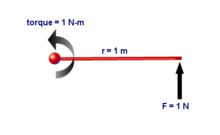Newton-metre: Difference between revisions
No edit summary |
No edit summary |
||
| Line 21: | Line 21: | ||
Newton-metres and joules are [[dimensional analysis|dimensionally]] equivalent in the sense that they have the same expression in [[SI base unit]]s, |
Newton-metres and joules are [[dimensional analysis|dimensionally]] equivalent in the sense that they have the same expression in [[SI base unit]]s, |
||
::<math>1 \, \text{N} {\cdot} \mathrm{m} = 1 \, \frac{\text{ |
::<math>1 \, \text{N} {\cdot} \mathrm{m} = 1 \, \frac{\text{kg} {\cdot} \text{m}^2}{\text{s}^2} \quad , \quad 1 \, \mathrm{J} = 1 \, \frac{\mathrm{kg} {\cdot} \mathrm{m}^2}{\mathrm{s}^2}</math> |
||
but are distinguished to avoid misunderstandings when a torque is mistaken for an energy or vice versa. Similar examples of dimensionally equivalent units include [[Pascal (unit)|Pa]] versus J/m<sup>3</sup>, [[Becquerel|Bq]] versus [[Hertz|Hz]], and [[ohm]] versus [[Sheet resistance|ohm per square]]. |
but are distinguished to avoid misunderstandings when a torque is mistaken for an energy or vice versa. Similar examples of dimensionally equivalent units include [[Pascal (unit)|Pa]] versus J/m<sup>3</sup>, [[Becquerel|Bq]] versus [[Hertz|Hz]], and [[ohm]] versus [[Sheet resistance|ohm per square]]. |
||
Revision as of 11:14, 14 May 2020
| Newton-metre | |
|---|---|
 One newton-metre is the torque resulting from a force of one newton applied perpendicularly to the end of a moment arm that is one metre long. | |
| General information | |
| Unit system | SI derived unit |
| Unit of | torque |
| Symbol | N⋅m, N m |
| Conversions | |
| 1 N⋅m in ... | ... is equal to ... |
| FPS system | 0.73756215 lbf ft |
| inch⋅pound-force | 8.8507 in lbf |
| inch⋅ounce-force | 141.6 in oz |
The newton-metre (also newton metre; symbol N⋅m[1] or N m[1]) is a unit of torque (also called moment) in the SI system. One newton-metre is equal to the torque resulting from a force of one newton applied perpendicularly to the end of a moment arm that is one metre long. The nonstandard notation Nm occurs in some fields.
The unit is also used less commonly as a unit of work, or energy, in which case it is equivalent to the more common and standard SI unit of energy, the joule.[2] In this usage the metre term represents the distance travelled or displacement in the direction of the force, and not the perpendicular distance from a fulcrum as it does when used to express torque. This usage is generally discouraged,[3] since it can lead to confusion as to whether a given quantity expressed in newton-metres is a torque or a quantity of energy.[4] However, since torque represents energy transferred or expended per angle of revolution, one newton-metre of torque is equivalent to one joule per radian.[4]
Newton-metres and joules are dimensionally equivalent in the sense that they have the same expression in SI base units,
but are distinguished to avoid misunderstandings when a torque is mistaken for an energy or vice versa. Similar examples of dimensionally equivalent units include Pa versus J/m3, Bq versus Hz, and ohm versus ohm per square.
Conversion factors
- 1 kilogram-force metre = 9.80665 N⋅m[5][6]
- 1 newton-metre ≈ 0.73756215 pound-force-feet
- 1 pound-foot ≡ 1 pound-force-foot ≈ 1.35581795 N⋅m
- 1 ounce-inch ≡ 1 ounce-force-inch ≈ 7.06155181 mN⋅m (millinewton-metres)
- 1 dyne-centimetre = 10−7 N⋅m
See also
- Bending moment
- Spring scale
- Torque tester
- Newton-second, the derived SI unit of impulse
References
- ^ a b BIPM – unit symbols
- ^ For example: Eshbach's handbook of engineering fundamentals - 10.4 Engineering Thermodynamics and Heat Transfer "In SI units the basic unit of energy is newton-metre".
- ^ Fundamentals of Physics, 9th edition by Halliday Resnick Ralker, p. 309. "The SI unit of torque is the newton-meter. In our discussion of energy we called this combination the joule. But torque is not work and torque should be expressed in newton-meters, not joules. google books link
- ^ a b BIPM - special names
- ^ Mechanical Engineering Formulas Pocket Guide, p6
- ^ Concise encyclopedia of plastics, by Donald V. Rosato, Marlene G. Rosato, Dominick V. Rosato, p621

